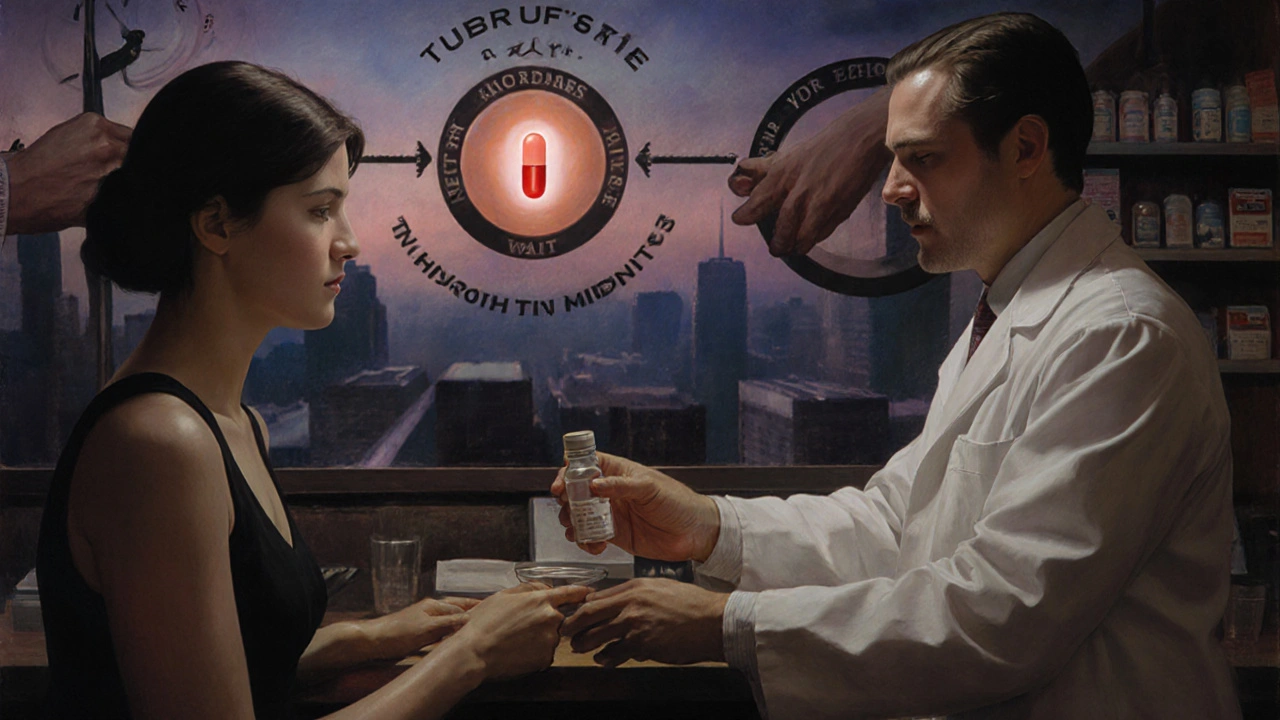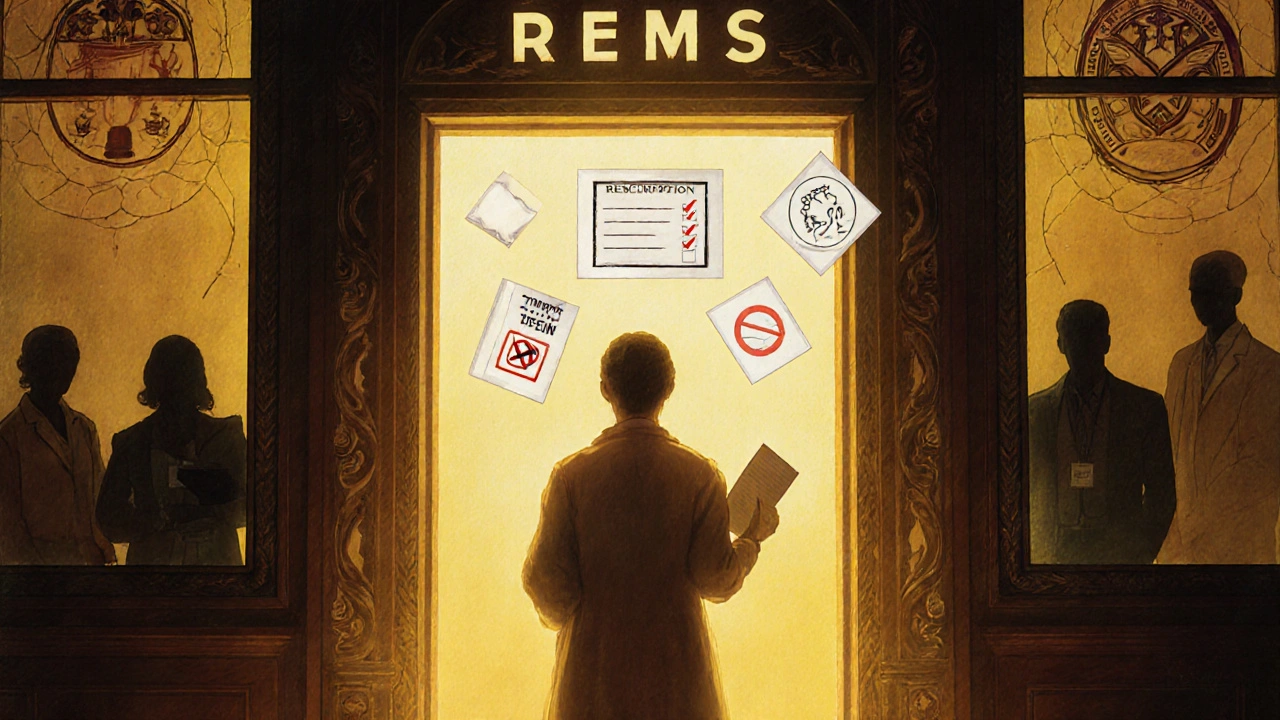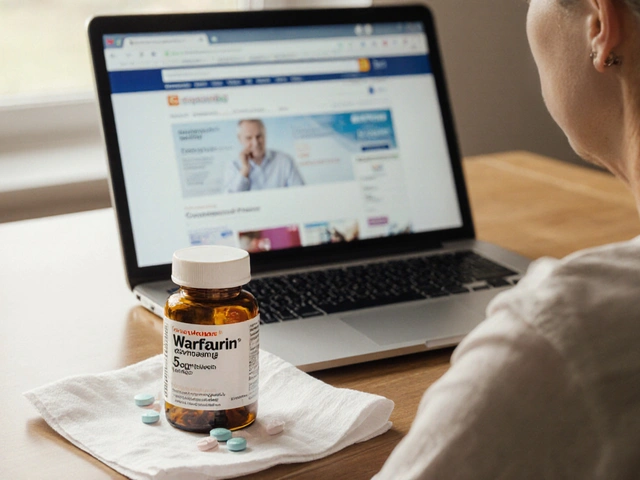Starting a new medication isn’t just about picking up a prescription. If that drug has serious risks, there’s a good chance it’s covered by a REMS program - and skipping the check could delay your treatment, put you at risk, or even break the law.
What Exactly Is a REMS?
REMS stands for Risk Evaluation and Mitigation Strategy. It’s a safety program required by the U.S. Food and Drug Administration (FDA) for certain medications that carry serious risks - like birth defects, life-threatening side effects, or high potential for abuse. These aren’t optional. If a drug has a REMS, you can’t legally get it without following the rules.
Think of REMS like a safety net. The FDA uses it to let patients access powerful drugs - like those for cancer, severe acne, or chronic pain - while making sure those drugs don’t cause more harm than good. As of 2025, there are 76 active REMS programs in the U.S. Some are simple. Others? They involve certification, registries, and mandatory waiting periods.
How Do You Know If Your Medication Has a REMS?
Not every drug has one. But if yours does, it’s clearly labeled. Start with the prescribing information - that’s the official document your doctor uses. Look for a section titled “REMS” or “Risk Evaluation and Mitigation Strategy.” It’ll spell out exactly what you need to do.
Another quick check: the Medication Guide. This is the paper handout you get every time you pick up your prescription. If it mentions REMS, you’re dealing with one. For example, isotretinoin (Accutane) includes a warning that you must be enrolled in iPLEDGE. Thalidomide says you need prescriber certification. Vyvanse tells you about its REMS program in the guide.
Still unsure? Go straight to the source. The FDA’s REMS Public Dashboard lets you search by drug name. Type in your medication - say, “mycophenolate” or “ozanimod” - and it shows you the exact REMS requirements, whether it’s a registry, training, or restricted distribution.
What Are the Common REMS Requirements?
Not all REMS are the same. They’re built around the specific danger of the drug. Here’s what you might run into:
- Medication Guides: Always given to patients. These explain risks in plain language. Keep them. Read them. They’re legally required at every refill.
- Prescriber Certification: Your doctor can’t write the script unless they’ve completed training and registered. For drugs like thalidomide or lenalidomide, this means logging into the manufacturer’s REMS portal, watching a video, passing a quiz, and getting certified. It takes about an hour.
- Patient Enrollment: Some programs require you to sign up. iPLEDGE for isotretinoin is the most famous. You, your doctor, and your pharmacy all need accounts. You must take two pregnancy tests, sign forms, and wait 48 hours between steps.
- Specialized Monitoring: Blood tests, EKGs, or regular check-ins. For example, patients on natalizumab (Tysabri) need monthly liver function tests and neurological exams.
- Restricted Distribution: The drug can only be dispensed by certified pharmacies or administered in certified clinics. Zyprexa Relprevv? You can’t get it at your local CVS. You need to go to a facility trained to watch you for three hours after injection because of the risk of sudden drowsiness or confusion.
Some REMS are so strict, they require all three: certification, registry, and restricted access. Others are just a Medication Guide and a warning. It depends on the drug.

Who’s Responsible for Checking REMS?
You might think your doctor handles it all. But the truth? It’s a team effort.
Doctors need to be certified. They must confirm you’re enrolled if required. They have to document everything. A 2019 AMA survey found doctors spend an extra 12.7 minutes per REMS prescription - just on paperwork.
Pharmacists are the last line of defense. If the REMS requires certification or enrollment, the pharmacy system will block the fill until those boxes are checked. One hospital pharmacist in Ohio told Reddit they cut isotretinoin processing time from 45 minutes to 15 minutes by using a checklist. That’s how critical this step is.
Patients can’t just sit back. If your doctor says, “You need to sign up for iPLEDGE,” don’t wait. Go to ipleDGEprogram.com right away. If your pharmacy says, “We need your certification number,” call your doctor’s office - don’t assume they already sent it.
What Happens If You Skip REMS?
Nothing good.
First, the pharmacy won’t fill the prescription. No exceptions. Even if your doctor scribbles it on paper, the system will reject it. You’ll get a call saying, “Your medication requires REMS compliance.”
Second, you could be at risk. Isotretinoin causes severe birth defects. Thalidomide can cause nerve damage. Opioid REMS exists because of overdose deaths. Skipping steps isn’t just bureaucratic - it’s dangerous.
Third, you might face delays. A 2022 survey by the National Organization for Rare Disorders found 42% of patients on REMS drugs had treatment delayed - on average, 6.2 business days. That’s over a week without medication because someone didn’t check the REMS.

How to Avoid Delays: A 3-Step Checklist
Here’s how to make sure you don’t get stuck:
- Ask your doctor upfront: “Does this medication have a REMS? What do I need to do?” Don’t wait for them to tell you. Ask at the first visit.
- Check the FDA REMS Dashboard: Search your drug name. Note if there’s a registry, certification, or restricted pharmacy. Write it down.
- Call your pharmacy: Ask if they’re certified to dispense it. If they say no, ask them to refer you to one that is. Some pharmacies specialize in REMS drugs.
Pro tip: Set a calendar reminder. Some REMS require re-certification every year. iPLEDGE needs a new pregnancy test every month for women of childbearing age. Miss one, and your script gets blocked.
What’s Changing in REMS in 2025?
The FDA is trying to fix the system. REMS used to be a nightmare - too many steps, too little communication. Now, they’re making changes:
- Mobile access: Since April 2023, all new REMS must include smartphone-friendly tools. You can now enroll, upload documents, and get reminders via apps.
- Electronic prescribing integration: Eight of the top 10 pharmacy benefit managers now check REMS status automatically when your doctor e-prescribes. No more phone calls to the pharmacy.
- Simplified requirements: The FDA has modified 14 REMS programs in 2022-2023 to cut red tape. For example, some opioid REMS now allow online training instead of in-person.
Still, challenges remain. A 2023 FDA report showed real-time updates on the REMS dashboard are sometimes delayed by up to two weeks. And manufacturers still spend $1.2 billion a year just to run these programs.
Bottom Line: Don’t Skip the Check
REMS isn’t bureaucracy for bureaucracy’s sake. It’s a safety layer for drugs that can save lives - or end them. Whether you’re on a powerful acne treatment, a painkiller, or a drug for a rare disease, knowing your REMS requirements isn’t optional. It’s part of your treatment plan.
Start by asking your doctor. Then check the FDA website. Confirm with your pharmacy. And never assume someone else has it covered. Your health depends on it.
Do all new medications have REMS requirements?
No. Only medications with serious safety risks - like those that can cause birth defects, severe organ damage, or death from misuse - require REMS. About 15-20% of new drugs approved by the FDA each year need a REMS. Most common medications like blood pressure pills or antibiotics do not.
Can I get a REMS medication if I live outside the U.S.?
REMS programs are U.S.-only. If you’re outside the U.S., you won’t be subject to FDA REMS rules. However, your country’s health authority may have its own safety programs for the same medication. Always check with your local pharmacist or regulator.
What if my doctor doesn’t know about the REMS?
It happens. Some doctors miss updates, especially for newer drugs. If your pharmacy flags a REMS requirement, ask your doctor to check the FDA REMS Public Dashboard or the manufacturer’s REMS website. Most drugmakers have dedicated REMS support lines. Your doctor’s office can call them directly to get certified.
Are REMS requirements the same for generics and brand-name drugs?
Yes. If a brand-name drug has a REMS, all its generic versions must follow the same rules. For example, if you’re prescribed generic isotretinoin, you still need to enroll in iPLEDGE. The REMS is tied to the drug’s active ingredient, not the brand name.
Can I switch pharmacies if my current one doesn’t handle REMS drugs?
Absolutely. Many pharmacies specialize in REMS medications. Call ahead and ask: “Do you dispense [drug name] and are you certified under its REMS program?” Chain pharmacies like CVS, Walgreens, and Kaiser Permanente often have certified locations. Independent pharmacies may need to apply for certification - so ask before you go.
Do I need to renew my REMS certification every year?
It depends on the drug. Some require annual re-certification for prescribers (like thalidomide). For patients, renewal is often tied to monitoring - like monthly pregnancy tests for isotretinoin or yearly lab work for certain immunosuppressants. Always check the REMS program’s official website for renewal deadlines.
What should I do if I’m denied a REMS medication because of a paperwork error?
Don’t panic. Ask the pharmacy for the exact reason - was it a missing signature? An expired certification? A failed pregnancy test? Then contact your doctor’s office immediately. Most REMS programs have customer support lines. For iPLEDGE, call 1-866-444-3737. For thalidomide, call Celgene at 1-800-526-7736. They can help fix errors quickly.







Comments(12)